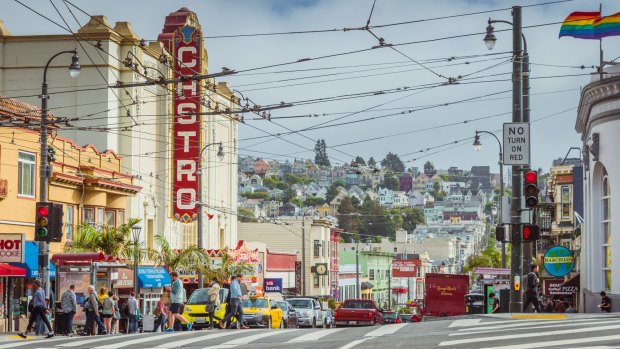This was published 7 years ago
The Castro district, San Francisco: Rainbow-coloured neighbourhood's dark past
By Steve Meacham

People crossing street at Castro District, San Francisco
It's a spectacular sunny Sunday morning in San Francisco's charming Castro district. However a strange mood is hanging over the city's most famous gay precinct.
There's just a week to go before the city celebrates its 46th Lesbian Gay Bisexual and Transgender Pride festival, and today the historic Castro Theatre is hosting Frameline 40, which bills itself as "the King of Queer film festivals".
But this is a community in grieving.
Less than a week before, America's worst peacetime massacre took place in Orlando when a hate-filled gunman slaughtered 48 people at Pulse, a gay nightclub.
The Castro could also be called "Milk Town". For this compact neighbourhood is where Harvey Milk - "the Mayor of Castro Street" - became the first openly gay person in the US to be elected for public office.
Sean Penn won his Oscar in 2008 playing Milk, who also became the first American to be assassinated for his sexual DNA when he and Mayor George Moscone were shot in 1978 by Dan White, a political rival.
So this is a bitter-sweet morning, resonant with memories and meaning.
Rainbow flags are flying proudly along Castro Street. Even the pedestrian crossings are rainbow coloured.
But at the junction of Castro and 18th streets there's a makeshift memorial of flowers, with names and photos and messages of condolence for those who died in Orlando.
Max, my Urban Hiker San Francisco guide, points out the stars on the newly-widened sidewalk along Castro Street. A fresh addition to The Castro, each one celebrates a famous LGBT hero: Tennessee Williams, Oscar Wilde, Gertrude Stein.
A few steps on, and Max stops in front of 575 Castro. Now it is the Human Rights Campaign office, but in 1973 it became the site of Castro Cameras, which the New York-born Milk and his younger partner Scott Smith set up with their last $1000 after a roll of film which Milk had left to be developed at a local shop was ruined. Milk and Smith lived above their store. Now there's a painted mural of Milk looking out of the upstairs window.
The Castro wasn't San Francisco's first gay district. According to the LGBT Museum which I visit after my tour is finished, the city's earliest known gay bar, The Dash (featuring female impersonators) was in North Beach and was shut down in 1908. In 1933, another female impersonator, Rae (aka Ray) Bourbon was arrested at Tait's Cafe in the Tenderloin (one of SF's earliest "Gayborhoods", along with Chinatown) as his show, Boys Will Be Girls, was being recorded live on radio.
The most haunting museum exhibit is the suit Milk was wearing the day he was gunned down at SF's ornate City Hall. If you press the button, you'll activate an excerpt from one of the three recordings Milk made predicting his own assassination.
Recorded on the night of November 18, 1977, soon after Milk won his seat as a "city supervisor" (there are 11 on the San Francisco Board of Supervisors), it makes harrowing listening.
Saying it should "be played only upon my death by assassination", Milk asks that if he is killed "every gay lawyer, every gay doctor, every gay architect (should) come out", to make life better for the next LGBT generation.
"If the bullet should enter my brain, let that bullet destroy every closet door in the country," Milk says.
Why did San Francisco become known as America's gay capital? Max explains that during World War II, the US military made a concerted effort to drum gays out of the armed forces. Many of those issued a "dishonourable discharge" were deposited at SF, the biggest US wartime Pacific port.
Rather than return home with their "shame", they decided to stay. And The Castro became their suburb of choice.
Across Castro Street, Max shows me what is now the Harvey's Restaurant and Bar. But in 1978 it was the Elephant Walk Bar.
When White - Moscone and Milk's murderer - was given the lightest possible sentence, it sparked what was known as the White Nights riot at City Hall.
In retaliation, the SFPD raided the Elephant Walk Bar, arresting anyone they could.
Fortunately our tour finishes on a happier note. As we arrive back at The Castro three hours later, Max points out the Twin Peaks Bar. "This isn't the oldest gay pub in the city, but it is the oldest to have such large windows," he says. "The LGBT community wanted to tell the world they weren't going to be hidden away any longer."
TRIP NOTES
MORE INFORMATION
GETTING THERE
Fiji Airways has a new, twice-weekly flight from Nadi to San Francisco, with connections to Sydney, Melbourne and Brisbane - which allows a Fijian stopover for a few days on the way there or back. See http://www.fijiairways.com.
STAYING THERE
The Kimpton Buchanan, on Sutter Street where Japantown, the Fillmore and Pacific Heights meet, is one of SF's newest boutique hotels, just a $2.25 bus ride from The Castro. See http://www.thebuchananhotel.com/
WALKING THERE
Urban Hikes San Francisco offers three walking tours that take you off the beaten track. Urban Jungles and City Heights (US$49) begins at The Castro and includes all but entrance to the LGBT Museum. See http://www.urbanhikersf.com/
Steve Meacham travelled courtesy of Fiji Airways and San Francisco Travel.
Sign up for the Traveller Deals newsletter
Get exclusive travel deals delivered straight to your inbox. Sign up now.